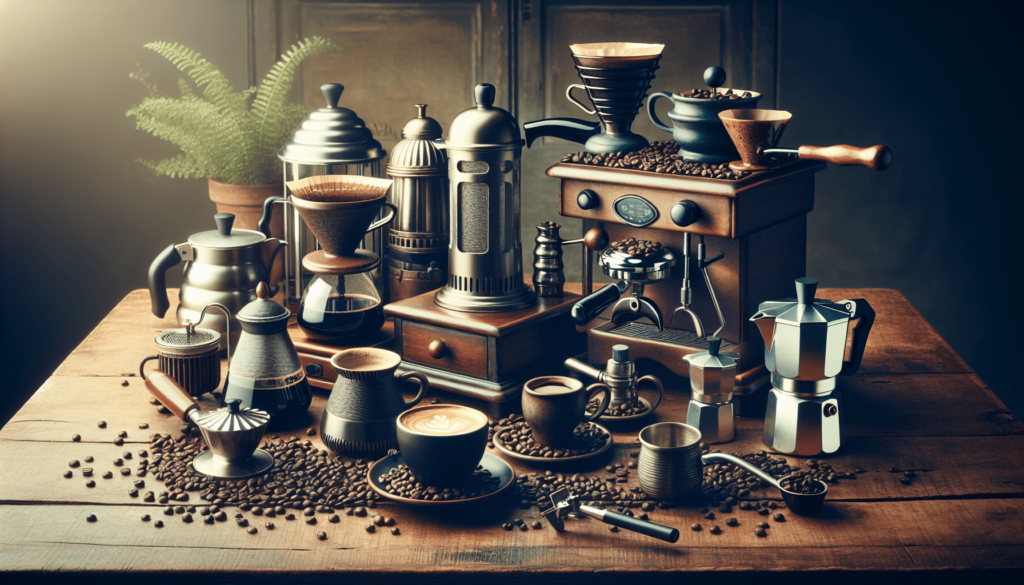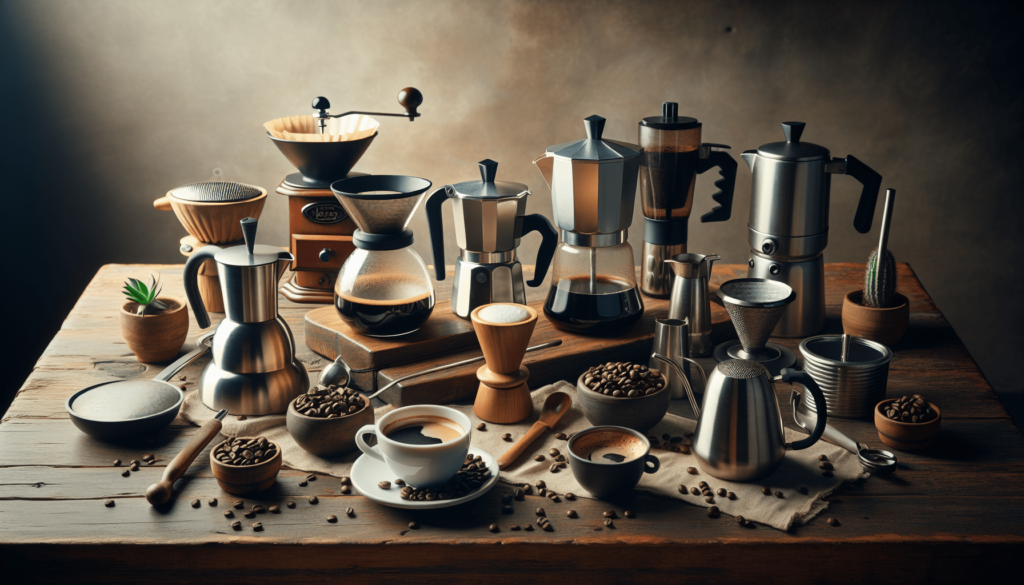Have you ever wondered just how many different ways there are to brew a cup of coffee? You’re certainly not alone! Coffee is one of the world’s favorite beverages, enjoyed by millions in a myriad of ways. With so many brewing methods, it can be overwhelming to determine which one might suit your taste the best. Let’s take a closer look at some popular brewing techniques, their unique advantages, and how you can master each one to perfectly tailor your daily caffeine fix.

The Basics of Coffee Brewing
Understanding the fundamentals of coffee brewing is essential before diving into the specifics of each method. The factors influencing your brew include the grind size, water temperature, brew time, and the coffee-to-water ratio.
-
Grind Size: The coarseness or fineness of your ground coffee affects the extraction process. Finer grinds are generally used for methods with shorter brewing times, while coarser grinds work better for slower methods.
-
Water Temperature: For optimal extraction, the water temperature should be between 195°F to 205°F (90°C to 96°C).
-
Brew Time: Different brewing methods require varying amounts of time, affecting the strength and flavor of your coffee.
-
Coffee-to-Water Ratio: A standard starting point is 1 gram of coffee for every 17 grams of water, but this can be adjusted based on personal preference.
Methods of Brewing Coffee
Drip Coffee Makers
Drip coffee makers are perhaps the most common household coffee brewing machines. They’re designed to be convenient and reliable, making them a staple in many homes and offices.
- How It Works: Ground coffee is placed in a filter holder. Water is heated and then poured over the grounds. The brewed coffee drips into a carafe.
- Advantages: Automated process, consistent results, and the ability to brew large batches.
- Disadvantages: Limited control over brewing variables.
French Press (Press Pot)
The French Press, also known as the press pot or plunger pot, is a popular manual brewing method that emphasizes simplicity and richness of flavor.
- How It Works: Coarsely ground coffee is placed in the carafe, followed by hot water. After a few minutes of steeping, the plunger is pressed down to filter the grounds.
- Advantages: Full-bodied flavor, control over brewing variables, and no paper filter required.
- Disadvantages: Can result in a gritty texture, requires careful measurement and timing.
Espresso Machine
Espresso machines use pressure to force hot water through finely-ground coffee, producing a concentrated and rich beverage.
- How It Works: Fine coffee grounds are tamped into a portafilter. Water is heated to approximately 200°F and forced through the grounds at 9 bars of pressure.
- Advantages: Produces a rich and intense flavor useful for a variety of coffee drinks (like lattes and cappuccinos), quick brewing process.
- Disadvantages: Expensive equipment, requires skill and practice.
Pour-Over
Pour-over coffee involves manually pouring hot water over coffee grounds in a filter, allowing precise control over the water flow.
- How It Works: Coffee grounds are placed in a filter inside a dripper. Hot water is then poured in a circular motion to ensure even saturation.
- Advantages: Enhanced control over brewing variables, cleaner and more nuanced flavors.
- Disadvantages: Time-consuming, requires attention to detail.
AeroPress
The AeroPress is a versatile and portable coffee maker that uses air pressure to produce a strong, espresso-like coffee.
- How It Works: Coffee grounds and water are mixed in a cylindrical chamber, then pressed through a filter using a plunger.
- Advantages: Portable, quick, easy to clean, and versatile (can make espresso-like coffee or American-style drip).
- Disadvantages: Limited capacity, steep learning curve for perfecting the method.
Moka Pot
The Moka Pot, also known as a stovetop espresso maker, brews coffee by passing boiling water through coffee grounds using steam pressure.
- How It Works: Water is heated in a lower chamber, creating steam pressure that forces the water through the coffee grounds in an upper chamber.
- Advantages: Inexpensive, produces strong coffee similar to espresso.
- Disadvantages: Requires manual supervision, can be difficult to achieve consistent results.
Cold Brew
Cold brew involves steeping coffee grounds in cold water for an extended period, resulting in a smooth, low-acidity coffee.
- How It Works: Coarse coffee grounds are mixed with cold water and left to steep for 12-24 hours. The mixture is then filtered to separate the grounds from the liquid.
- Advantages: Smooth, low-acidity flavor, can be made in large batches, very refreshing.
- Disadvantages: Long preparation time, requires careful planning.
Siphon Brewer
A siphon brewer, also known as a vacuum pot, uses vapor pressure and vacuum force to brew coffee, creating a visually impressive experience.
- How It Works: Water is heated in a lower chamber, producing vapor pressure that forces the water into an upper chamber containing the coffee grounds. Once brewing is complete, gravity pulls the coffee back down through a filter.
- Advantages: Unique brewing process, full-bodied and aromatic coffee.
- Disadvantages: Expensive, complicated to use and clean.
Turkish Coffee
Turkish coffee is one of the oldest brewing methods, known for its strong and rich flavor. It requires extremely fine coffee grounds and a special pot called a cezve.
- How It Works: Water, sugar, and finely-ground coffee are mixed in a cezve and heated until the coffee foams. The brew is allowed to settle before serving.
- Advantages: Rich, strong, and aromatic coffee, cultural experience.
- Disadvantages: Gritty texture, requires skill to prepare correctly.
Percolator
Percolators were once a common household brewing method but have fallen out of favor due to the rise of drip coffee makers.
- How It Works: Water is boiled in a lower chamber, creating pressure that forces it upward into a basket containing coffee grounds. The brewed coffee then drips back down.
- Advantages: Strong and hot coffee, nostalgic value.
- Disadvantages: Prone to over-extraction, which can result in a bitter taste.
Brewing Comparisons: A Quick Guide
For quick reference, here’s a comparison of the different brewing methods mentioned above:
| Brewing Method | Grind Size | Water Temp | Brew Time | Strength | Complexity |
|---|---|---|---|---|---|
| Drip Coffee | Medium | 195-205°F | 5-10 mins | Moderate | Low |
| French Press | Coarse | 195-205°F | 4 mins | Full-bodied | Medium |
| Espresso Machine | Fine | ~200°F | 20-30 secs | Very strong | High |
| Pour-Over | Medium-Fine | 195-205°F | 3-4 mins | Clean, nuanced | Medium |
| AeroPress | Fine | 175-205°F | 1-2 mins | Versatile | Medium |
| Moka Pot | Fine | ~200°F | 5-10 mins | Strong | Medium |
| Cold Brew | Coarse | Cold | 12-24 hrs | Smooth, mild | Low |
| Siphon Brewer | Medium | 195-205°F | 6-8 mins | Aromatic | High |
| Turkish Coffee | Extra Fine | Boiling | 5-7 mins | Very strong | High |
| Percolator | Coarse | Boiling | 5-10 mins | Strong | Medium |
Tips for Perfecting Your Brew
Regardless of the method you choose, there are several tips to keep in mind to perfect your coffee brewing skills:
- Use Fresh Coffee: Freshly roasted coffee beans will always yield a better flavor than stale ones.
- Measure Accurately: Use a scale to measure your coffee and water for consistent results.
- Mind Your Water: The quality of water can greatly affect the taste of your coffee. Use filtered water if possible.
- Preheat Your Equipment: Preheating your brewing equipment ensures the coffee stays at the optimal temperature throughout the brewing process.
- Experiment: Don’t be afraid to tweak variables like grind size, water temperature, and brew time to find what works best for your taste preference.

Conclusion
There are countless ways to enjoy coffee, each method offering its own unique characteristics and flavors. Whether you prefer the convenience of a drip coffee maker, the robust flavor of a French Press, or the precision of a pour-over, there’s a brewing method out there that’s perfect for you. Experiment with different methods and enjoy the journey of discovering your ideal cup of coffee.
